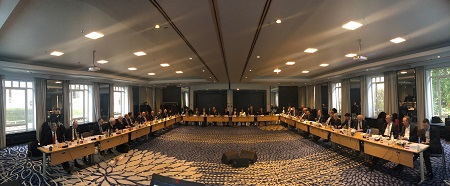Economic outlook and trends: an uncertain future after a period of strong growth
CECIMO and its national associations close 2019 amidst industrial and trade uncertainties. Production and consumption seem stagnant while trade with foreign markets is threated by political challenges, from Brexit to the US-China trade war. Moreover, business sentiment seems to be at a low point for the first time in many years which is additionally affected by the strategic challenges and uncertainty within the automotive sector. But the European machine tool industry has strong foundations and the technological know-how to be successful moving forward. The environmental and political factors affecting the automotive sector also create increased motivation for manufacturers to improve productivity and sustainability which will offer significant opportunities for innovation in our sector.
2019 estimates show that MT production in Europe stands at 27,1 billion euros, a -3,0% drop compared to 2018. Although this decrease breaks the upward trend started in 2017, it is nonetheless an adjustment after a record-breaking year that saw a production volume of 28 billion euros. Moreover, if we consider CECIMO’s share over global production output for 2019, we see that it stands at 35%, just 1% below 2018’s share. It is also 3% higher than CECIMO’s global turnover share of 2017 (32%). Global MT output is forecast to decrease as well in 2019. CECIMO estimates that global production currently sits a 77,5 billion euros (-3,4% compared to data from 2018).
In terms of trade, European MT manufactures continue to perform well abroad. The registered export volume for 2018 was 21,6 billion euros, an 8,3% increase from 2017’s levels. It would be the second year in a row with a growth rate greater than 8% (2017 saw an increase of 8,1% compared to 2016, with total exports adding up to 20 billion euros). European MT builders remain very competitive abroad and that strong position will continue... CECIMO top five export destinations are: China (26% of exports outside of CECIMO countries), the United Sates (18,4%), Poland (8,2%), Russia (4,6%) and Mexico (3,9%).
CECIMO internal figures suggest that MT consumption will decrease -2,9% in 2019 (from 16,5 billion euros in 2018 to 16 billion this year). It would be the first drop in consumption after six years of consistent growth. Oxford Economics forecasts shows that MT consumption among European companies will further decrease in 2020, but should pick up with the pace soon after, with relatively strong growth rates expected in 2021 (3,9%), 2022 (3,1%) and 2023 (2,6%).

Trends might be shifting in the world economy and the global machine tool industry, but data shows that European MT builders are still at the forefront in production, exports and consumption. Marcus Burton, Chairman of CECIMO’s Economic Committee, assessed the situation of European MT companies in 2019 and stated: “our businesses face uncertainty about the economy in the short term, and this is understandable given the political and trade challenges around the world as well as the uncertainty in the automotive sector. However, they continue to perform well, delivering innovative new products and solutions that were in abundance at EMO 2019. Machine Tool customers should remain committed to a long-term strategy of investing in technologies that hold the key to improving their future competitiveness. Short term uncertainty should not steer them away from the right path”.
The future of the Machinery Directive
The Machinery Directive (2006/42/EC) is one of the main pieces of legislation affecting the machine tool sector. The European Commission started in 2016 a process to understand whether the Directive needed a revision.
One of the main issues being considered is the need to update the Directive to take into account emerging digital technologies. CECIMO questions, though, whether there is a need to introduce changes in the Directive. From our perspective, the requirements of the Directive already provide a robust framework to place safe products, including new technologies such as Artificial Intelligence (AI), on the market. “Although AI and technologies alike have evolved considerably in the last decades, the development of applications in the machine tool sector is still at an early stage. Companies looking at the possibilities of these technologies are developing applications mainly for process optimization, predictive maintenance and condition monitoring” said Massimo Carboniero Chairman of the CECIMO Technical Committee. Industry believes that rather than changes in legislation there is a need to revise standards in line with technological developments and the state-of-the-art.
Cybersecurity is also an issue at stake, which involves a wide range of actors including not only manufacturers but also suppliers, software providers and users. “The inclusion of cybersecurity requirements in a revised Directive would not lead to an effective approach to cybersecurity and, instead, may open the way to a situation where different legislations will include requirements on cybersecurity, making it inconsistent” commented Mr Carboniero. CECIMO supports a horizontal approach to deal with cybersecurity aspects.
Lastly, another issue under discussion is the possibility to provide instructions on digital format. CECIMO points out that manufacturers should be free to choose the best means to provide the required documentation, as long as the requirements of the Directive are fulfilled, and the required information is provided. There are many advantages in the use of digital manuals including the possibility of easier updates, reduction of printing costs and environmental impact. Since complex machinery is usually accompanied by complex manuals, digital solutions would allow to find the right information quickly, especially if integrated with augmented reality solutions.
All these issues were restated during a breakfast briefing organised by CECIMO on 5 December 2019. The event was hosted by Maria Grapini MEP and saw the participation of many MEPs, EU officials, representatives from Permanent representations of EU countries and industry stakeholders. The debate on the above issues was intense and showed support to CECIMO position.














